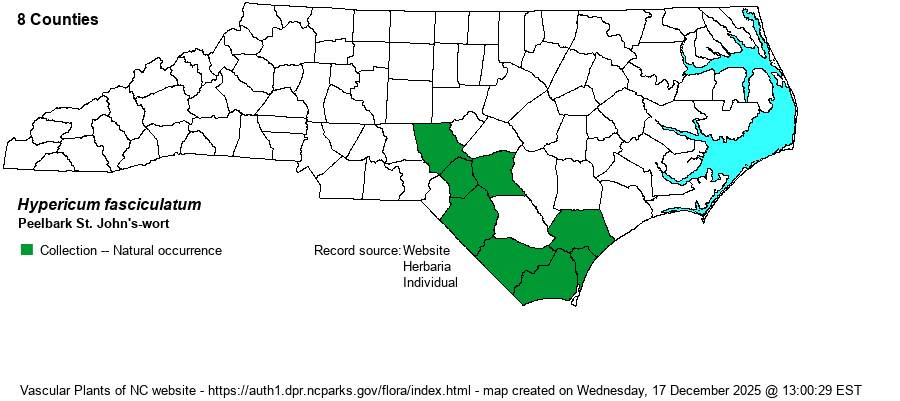| Author | Lamarck | |
| Distribution | Found only in the southern Coastal Plain, ranging north to the Sandhills (to Moore County) and east to Pender and New Hanover counties.
This is a strict Southern Atlantic and Gulf Coastal Plain species. It ranges north only to southern NC and south through FL, and then west to eastern LA.
| |
| Abundance | Rare. This is a State Endangered species. | |
| Habitat | This Hypericum species grows in shallow standing water, typically in pools, pond margins (including beaver ponds), clay-based Carolina bays (at least under cypress), and various wet spots in pinelands. It may be found with the very similar H. galioides, but the latter species often is found in slightly drier areas and not necessarily in shallow water. | |
| Phenology | Blooms from May into September, and fruits shortly after blooming. | |
| Identification | This is a deciduous shrub that grows only to about 3-4 feet tall, and as it is much branched, it may be wider than tall. It has bark that is thin and peels off into long strips. Growing in water, it often has a somewhat swollen and spongy base. It has opposite and extremely narrow leaves, practically needle-like, and ranging only to about 2/3-inch long. Also, there are numerous other leaves growing in the leaf axils, and thus this shrub is full of short and spiny-looking leaves all over the stems. It has medium-sized yellow flowers at the branch tips; flowers are about 1/2-inch across. NOTE: The quite similar H. nitidum, which was listed for one county in NC in RAB (1968), has been determined to not occur in NC and thus should not be a species for consideration. In general, identify H. fasciculatum by the many small “fascicles” of needle-like leaves in the axils – which is implied by the Latin name for the species. Check keys for separation from the similar and much more common H. galioides, which has slightly wider leaves (not quite needle-like). See Sorrie (2012) for detailed info on all needle-leaved Hypericum. | |
| Taxonomic Comments | None
| |
| Other Common Name(s) | Sandweed (a horrible name, as it is not a sandy soil species, is hardly a weed, and the name has no connection to a Hypericum) | |
| State Rank | S1 | |
| Global Rank | G5 | |
| State Status | E | |
| US Status | | |
| USACE-agcp | FACW link |
| USACE-emp | FACW link |

